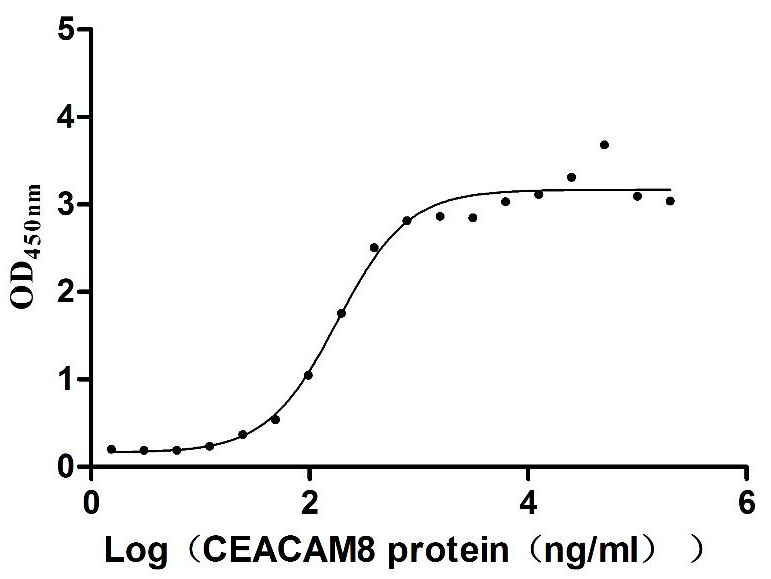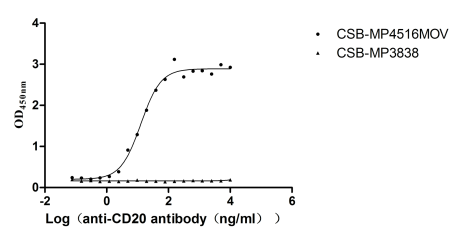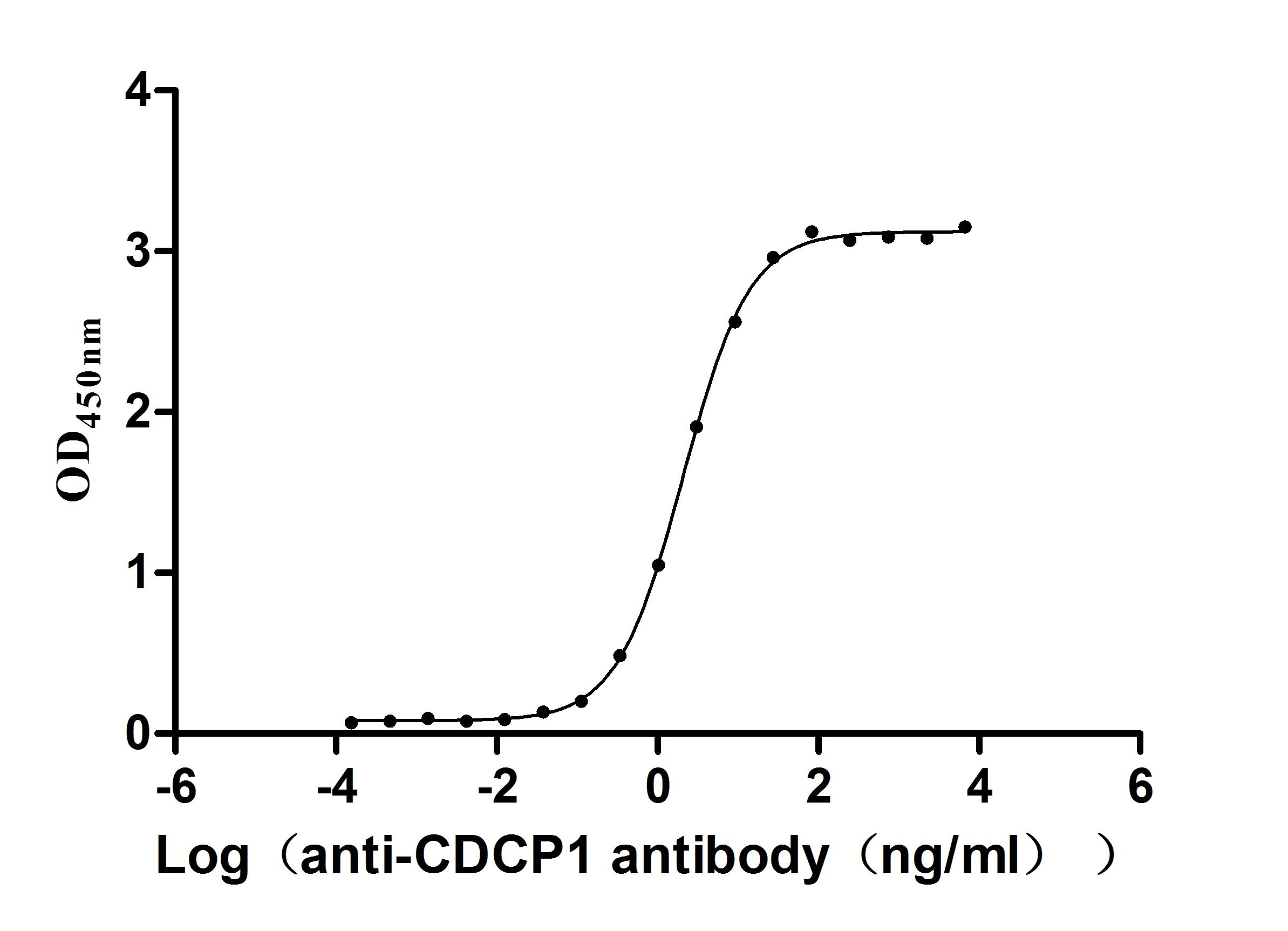Recombinant Mouse Angiomotin (Amot), partial
-
中文名稱:Recombinant Mouse Angiomotin(Amot) ,partial,Yeast
-
貨號:CSB-YP001677MO
-
規(guī)格:
-
來源:Yeast
-
其他:
-
中文名稱:Recombinant Mouse Angiomotin(Amot) ,partial,Yeast
-
貨號:CSB-EP001677MO
-
規(guī)格:
-
來源:E.coli
-
其他:
-
中文名稱:Recombinant Mouse Angiomotin(Amot) ,partial,Yeast
-
貨號:CSB-EP001677MO-B
-
規(guī)格:
-
來源:E.coli
-
共軛:Avi-tag Biotinylated
E. coli biotin ligase (BirA) is highly specific in covalently attaching biotin to the 15 amino acid AviTag peptide. This recombinant protein was biotinylated in vivo by AviTag-BirA technology, which method is BriA catalyzes amide linkage between the biotin and the specific lysine of the AviTag.
-
其他:
-
中文名稱:Recombinant Mouse Angiomotin(Amot) ,partial,Yeast
-
貨號:CSB-BP001677MO
-
規(guī)格:
-
來源:Baculovirus
-
其他:
-
中文名稱:Recombinant Mouse Angiomotin(Amot) ,partial,Yeast
-
貨號:CSB-MP001677MO
-
規(guī)格:
-
來源:Mammalian cell
-
其他:
產(chǎn)品詳情
-
純度:>85% (SDS-PAGE)
-
基因名:Amot
-
Uniprot No.:
-
別名:Amot; Kiaa1071Angiomotin
-
種屬:Mus musculus (Mouse)
-
蛋白長度:Partial
-
蛋白標(biāo)簽:Tag?type?will?be?determined?during?the?manufacturing?process.
The tag type will be determined during production process. If you have specified tag type, please tell us and we will develop the specified tag preferentially. -
產(chǎn)品提供形式:Lyophilized powder
Note: We will preferentially ship the format that we have in stock, however, if you have any special requirement for the format, please remark your requirement when placing the order, we will prepare according to your demand. -
復(fù)溶:We recommend that this vial be briefly centrifuged prior to opening to bring the contents to the bottom. Please reconstitute protein in deionized sterile water to a concentration of 0.1-1.0 mg/mL.We recommend to add 5-50% of glycerol (final concentration) and aliquot for long-term storage at -20℃/-80℃. Our default final concentration of glycerol is 50%. Customers could use it as reference.
-
儲存條件:Store at -20°C/-80°C upon receipt, aliquoting is necessary for mutiple use. Avoid repeated freeze-thaw cycles.
-
保質(zhì)期:The shelf life is related to many factors, storage state, buffer ingredients, storage temperature and the stability of the protein itself.
Generally, the shelf life of liquid form is 6 months at -20°C/-80°C. The shelf life of lyophilized form is 12 months at -20°C/-80°C. -
貨期:Delivery time may differ from different purchasing way or location, please kindly consult your local distributors for specific delivery time.Note: All of our proteins are default shipped with normal blue ice packs, if you request to ship with dry ice, please communicate with us in advance and extra fees will be charged.
-
注意事項(xiàng):Repeated freezing and thawing is not recommended. Store working aliquots at 4°C for up to one week.
-
Datasheet :Please contact us to get it.
靶點(diǎn)詳情
-
功能:Plays a central role in tight junction maintenance via the complex formed with ARHGAP17, which acts by regulating the uptake of polarity proteins at tight junctions. Appears to regulate endothelial cell migration and tube formation. May also play a role in the assembly of endothelial cell-cell junctions.
-
基因功能參考文獻(xiàn):
- Rho attenuates the interaction between Amot and Nf2 by binding to the coiled-coil domain of Amot. PMID: 28947533
- a new function of RNF146 and tankyrase in stabilizing the Crumbs complex through downregulation of AMOT proteins at the apical membrane, is reported. PMID: 27521426
- AMOT is a crucial suppressor of lung cancer metastasis and highlight its critical role as a tumor suppressor and its potential as a prognostic biomarker and therapeutic target for lung cancer. PMID: 25381822
- The loss of Angiomotin, together with Angiomotin-like 2, leads to differentiation of inner cell mass cells and compromised peri-implantation development. PMID: 23903990
- The phosphorylation of S176 in the N-terminal domain of Amot is a critical step for activation of the Hippo pathway in adherens junctions and cell polarity disconnects the Hippo pathway from cell-cell adhesion by sequestering Amot from AJs. PMID: 23791731
- Amot, Amotl1, and Amotl2 are differentially expressed in uterine cells during the peri-implantation period. PMID: 22813598
- A vaccine targeting angiomotin induces an antibody response which alters tumor vessel permeability and hampers the growth of established tumors. PMID: 22426512
- Depletion of Angiomotin in Nf2(-/-) Schwann cells attenuates the Ras-MAPK signaling pathway, impedes cellular proliferation in vitro and tumorigenesis in vivo PMID: 21481793
- Angiomotin may promote neoplastic angiogenesis by both stimulating invasion as well as stabilizing established tubes. PMID: 14730344
- angiomotin, in addition to controlling cell motility, may play a role in the assembly of endothelial cell-cell junctions PMID: 16043488
- p80- and p130-angiomotin play coordinating roles in vascular tube formation by affecting cell migration and cell shape, respectively. PMID: 16640563
- Data show that MUPP1 interacts with angiomotin (Amot), JEAP/Amot-like 1 and MASCOT/Amot-like 2, and that all the Amot/JEAP family proteins also interacted with Patj, a close relative of MUPP1. PMID: 17397395
- 75% of Amot knockout mice die between embryonic day 11 (E11) and E11.5 and exhibit severe vascular insufficiency in the intersomitic region as well as dilated vessels in the brain. PMID: 17699752
- Homo-oligomerization of p80-Amot and hetero-oligomerization of both isoforms are critical for a switch between a migratory and a non-migratory cell phenotype in endothelial cells. PMID: 18164266
- Amot and AmotL1 have similar effects on endothelial migration and tight junction formation in vitro. In vivo Amot appears to control the cell polarity and AmotL1 affects the stability of cell-cell junctions. PMID: 19590046
顯示更多
收起更多
-
亞細(xì)胞定位:Cell junction, tight junction.
-
蛋白家族:Angiomotin family
-
組織特異性:Expressed in brain, skeletal muscle and placenta.
-
數(shù)據(jù)庫鏈接:
Most popular with customers
-
Recombinant Human Semaphorin-4D (SEMA4D), partial (Active)
Express system: Mammalian cell
Species: Homo sapiens (Human)
-
Express system: Mammalian cell
Species: Homo sapiens (Human)
-
Recombinant Macaca mulatta Microtubule-associated protein tau (MAPT) (Active)
Express system: Mammalian cell
Species: Macaca mulatta (Rhesus macaque)
-
Recombinant Human Carcinoembryonic antigen-related cell adhesion molecule 6 (CEACAM6) (Active)
Express system: Mammalian cell
Species: Homo sapiens (Human)
-
Recombinant Macaca fascicularis Membrane spanning 4-domains A1 (MS4A1)-VLPs (Active)
Express system: Mammalian cell
Species: Macaca fascicularis (Crab-eating macaque) (Cynomolgus monkey)
-
Recombinant Macaca fascicularis zymogen granule protein 16 homolog B (ZG16B) (Active)
Express system: Mammalian cell
Species: Macaca fascicularis (Crab-eating macaque) (Cynomolgus monkey)
-
Recombinant Macaca fascicularis CUB domain containing protein 1 (CDCP1), partial (Active)
Express system: Mammalian cell
Species: Macaca fascicularis (Crab-eating macaque) (Cynomolgus monkey)
-
Recombinant Human C-C chemokine receptor type 6(CCR6)-VLPs (Active)
Express system: Mammalian cell
Species: Homo sapiens (Human)




















